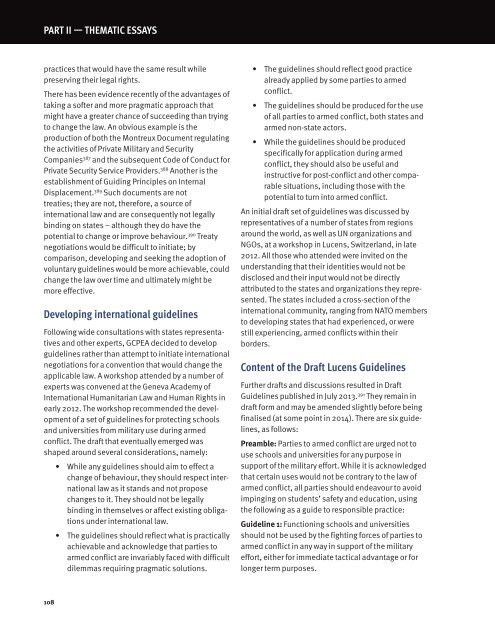eua_2014_full.pdf?utm_content=buffer4a392&utm_medium=social&utm_source=twitter
eua_2014_full.pdf?utm_content=buffer4a392&utm_medium=social&utm_source=twitter
eua_2014_full.pdf?utm_content=buffer4a392&utm_medium=social&utm_source=twitter
- No tags were found...
Create successful ePaper yourself
Turn your PDF publications into a flip-book with our unique Google optimized e-Paper software.
PART II — THeMATIC eSSAYSpractices that would have the same result whilepreserving their legal rights.There has been evidence recently of the advantages oftaking a softer and more pragmatic approach thatmight have a greater chance of succeeding than tryingto change the law. An obvious example is theproduction of both the Montreux Document regulatingthe activities of Private Military and SecurityCompanies 387 and the subsequent Code of Conduct forPrivate Security Service Providers. 388 Another is theestablishment of Guiding Principles on InternalDisplacement. 389 Such documents are nottreaties; they are not, therefore, a source ofinter national law and are consequently not legallybinding on states – although they do have thepotential to change or improve behaviour. 390 Treatynegotiations would be difficult to initiate; bycomparison, developing and seeking the adoption ofvoluntary guidelines would be more achievable, couldchange the law over time and ultimately might bemore effective.Developing international guidelinesFollowing wide consultations with states representativesand other experts, GCPEA decided to developguidelines rather than attempt to initiate internationalnegotiations for a convention that would change theapplicable law. A workshop attended by a number ofexperts was convened at the Geneva Academy ofInternational Humanitarian Law and Human Rights inearly 2012. The workshop recommended the developmentof a set of guidelines for protecting schoolsand universities from military use during armedconflict. The draft that eventually emerged wasshaped around several considerations, namely:• While any guidelines should aim to effect achange of behaviour, they should respect internationallaw as it stands and not proposechanges to it. They should not be legallybinding in themselves or affect existing obligationsunder international law.• The guidelines should reflect what is practicallyachievable and acknowledge that parties toarmed conflict are invariably faced with difficultdilemmas requiring pragmatic solutions.• The guidelines should reflect good practicealready applied by some parties to armedconflict.• The guidelines should be produced for the useof all parties to armed conflict, both states andarmed non-state actors.• While the guidelines should be producedspecifically for application during armedconflict, they should also be useful andinstructive for post-conflict and other comparablesituations, including those with thepotential to turn into armed conflict.An initial draft set of guidelines was discussed byrepresentatives of a number of states from regionsaround the world, as well as UN organizations andNGOs, at a workshop in Lucens, Switzerland, in late2012. All those who attended were invited on theunderstanding that their identities would not bedisclosed and their input would not be directlyattributed to the states and organizations they represented.The states included a cross-section of theinternational community, ranging from NATO membersto developing states that had experienced, or werestill experiencing, armed conflicts within theirborders.Content of the Draft Lucens GuidelinesFurther drafts and discussions resulted in DraftGuidelines published in July 2013. 391 They remain indraft form and may be amended slightly before beingfinalised (at some point in <strong>2014</strong>). There are six guidelines,as follows:Preamble: Parties to armed conflict are urged not touse schools and universities for any purpose insupport of the military effort. While it is acknowledgedthat certain uses would not be contrary to the law ofarmed conflict, all parties should endeavour to avoidimpinging on students’ safety and education, usingthe following as a guide to responsible practice:Guideline 1: Functioning schools and universitiesshould not be used by the fighting forces of parties toarmed conflict in any way in support of the militaryeffort, either for immediate tactical advantage or forlonger term purposes.108


